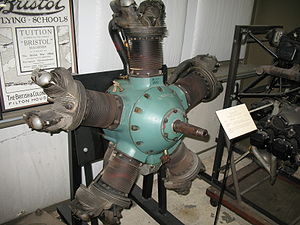Kinner B-5
| B-5 | |
|---|---|
 | |
| A Kinner B-5 on display at the Old Rhinebeck Aerodrome in New York, as used in their Fleet Finch biplane. | |
| Type |
Radial engine |
| Manufacturer |
Kinner Airplane & Motor Corporation |
Developed from |
Kinner K-5 |
Developed into |
Kinner R-5 |
The Kinner B-5 was a popular five cylinder American radial engine for light general and sport aircraft of the 1930s.
Contents
1 Design and development
2 Applications
3 Specifications (Kinner B-5)
3.1 General characteristics
3.2 Components
3.3 Performance
4 See also
5 References
6 Further reading
7 External links
Design and development
The B-5 was a development of the earlier K-5 with slightly greater power and dimensions. The main change was the increase in cylinder bore from 108 mm (4.25 in) to 117 mm (4.625 in) and a corresponding increase in displacement from 372 cu in (6.1 liters ) to 441 cu in (7.2 liters ). One difference the B-5 had from radial engines of other manufacturers was that each individual cylinder had its own camshaft, a system also used by the contemporary Soviet-built, 8.6 litre-displacement Shvetsov M-11 five cylinder radial, while most other radial engine designs used a "cam ring" for the same purpose, connected to every cylinder's valves. The B-5 was a rough running but reliable engine. The B-5 and its derivatives were produced in the thousands, powering many World War II trainer aircraft; its military designation was R-440. The B-5 was followed by the R-5 and R-55.
Applications
- Fleet Fawn
- Fleet Finch
- Kinner Sportster
- Kinner Sportwing
- Monocoupe 125
- Redfern DH-2
Ryan PT-22 Recruit
- Savoia-Marchetti S.56
Specifications (Kinner B-5)
Data from Jane's all the World's Aircraft 1938[1]
General characteristics
Type: Five-cylinder, air-cooled, radial
Bore: 4.625 in (117.5 mm)
Stroke: 5.25 in (133 mm)
Displacement: 441 cu in (7.23 l)
Length: 32.325 in (821.1 mm)
Diameter: 45.375 in (1,152.5 mm)
Dry weight: 295 lb (134 kg)
Components
Valvetrain: 1 Inlet and 1 Exhaust valve per cylinder, individual camshafts for each cylinder
Fuel system: 1x Holley or Stromberg Carburetor
Fuel type: 73 Octane
Oil system: Circulating dry sump system
Cooling system: Air-cooled
Performance
Power output: 125 hp (93 kW) at 1,925 rpm max; 89 hp (66 kW) at 1,725 rpm cruise
Compression ratio: 5.25:1
Specific fuel consumption: 0.60 lb/hp hr (0.365 kg/kw hr)
Oil consumption: 0.025 lb/hp hr (0.0152 kg/kw hr)
Power-to-weight ratio: 0.42 hp/lb at cruise
See also
Related development
- Kinner K-5
- Kinner R-5
Comparable engines
- Armstrong Siddeley Genet Major
- Shvetsov M-11
Related lists
- List of aircraft engines
References
| Wikimedia Commons has media related to Kinner B-5. |
^ Grey, C.G.; Bridgman, Leonard, eds. (1938). Jane's all the World's Aircraft 1938. London: Sampson Low, Marston & company, ltd. p. 88d..mw-parser-output cite.citation{font-style:inherit}.mw-parser-output .citation q{quotes:"""""""'""'"}.mw-parser-output .citation .cs1-lock-free a{background:url("//upload.wikimedia.org/wikipedia/commons/thumb/6/65/Lock-green.svg/9px-Lock-green.svg.png")no-repeat;background-position:right .1em center}.mw-parser-output .citation .cs1-lock-limited a,.mw-parser-output .citation .cs1-lock-registration a{background:url("//upload.wikimedia.org/wikipedia/commons/thumb/d/d6/Lock-gray-alt-2.svg/9px-Lock-gray-alt-2.svg.png")no-repeat;background-position:right .1em center}.mw-parser-output .citation .cs1-lock-subscription a{background:url("//upload.wikimedia.org/wikipedia/commons/thumb/a/aa/Lock-red-alt-2.svg/9px-Lock-red-alt-2.svg.png")no-repeat;background-position:right .1em center}.mw-parser-output .cs1-subscription,.mw-parser-output .cs1-registration{color:#555}.mw-parser-output .cs1-subscription span,.mw-parser-output .cs1-registration span{border-bottom:1px dotted;cursor:help}.mw-parser-output .cs1-ws-icon a{background:url("//upload.wikimedia.org/wikipedia/commons/thumb/4/4c/Wikisource-logo.svg/12px-Wikisource-logo.svg.png")no-repeat;background-position:right .1em center}.mw-parser-output code.cs1-code{color:inherit;background:inherit;border:inherit;padding:inherit}.mw-parser-output .cs1-hidden-error{display:none;font-size:100%}.mw-parser-output .cs1-visible-error{font-size:100%}.mw-parser-output .cs1-maint{display:none;color:#33aa33;margin-left:0.3em}.mw-parser-output .cs1-subscription,.mw-parser-output .cs1-registration,.mw-parser-output .cs1-format{font-size:95%}.mw-parser-output .cs1-kern-left,.mw-parser-output .cs1-kern-wl-left{padding-left:0.2em}.mw-parser-output .cs1-kern-right,.mw-parser-output .cs1-kern-wl-right{padding-right:0.2em}
Further reading
Gunston, Bill (1986). World Encyclopedia of Aero Engines. Newton Abbot: Patrick Stephens. pp. 99–100.
External links
- http://www.oldengine.org/members/diesel/Duxford/usaero4.htm

Comments
Post a Comment